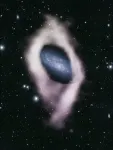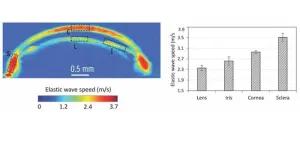(Press-News.org) An infectious diseases surveillance system created by University of Pittsburgh School of Medicine scientists and deployed at a UPMC hospital successfully flagged cases of a drug-resistant infection spread by eye drops months before national public health officials announced an outbreak.
The findings, published today in The Journal of Infectious Diseases, were obtained through a hospital-based program called Enhanced Detection System for Healthcare-Associated Transmission (EDS-HAT). They demonstrate the potential of this technology to detect and stop nationwide outbreaks sooner.
“Our study really showcases the utility of whole genome sequencing surveillance,” said senior author Daria Van Tyne, Ph.D., assistant professor in Pitt Medicine’s Division of Infectious Diseases. “If more hospitals were to use EDS-HAT or a similar increasingly accessible technology, they could head off outbreaks within their walls much faster. And if multiple hospitals share this data with each other and public health authorities, then national outbreaks could be stopped in their tracks.”
Whole genome sequencing allows scientists to see the unique DNA “fingerprints” of pathogens in a sample from a patient with an infection. When the genetic code from two different patient samples is very closely matched, it means either one patient somehow gave the infection to the other or they both got it from the same source, indicating an outbreak.
UPMC, a nonprofit health care provider with hospitals in Pennsylvania, New York and Maryland, is the only U.S. hospital system that Van Tyne is aware of using whole genome sequencing in this way.
On February 1, 2023, the U.S. Centers for Disease Control and Prevention issued an advisory warning of an outbreak of a drug resistant strain of the bacteria Pseudomonas aeruginosa that was linked to use of artificial tears. Dozens of cases in 13 states had been found, with at least one death and multiple cases of permanent vision loss. In April 2023, CDC released the genetic code for the outbreak strain.
At that point, Alexander Sundermann, Dr.P.H., lead author of the study and assistant professor in Pitt Medicine’s Division of Infectious Diseases, compared the CDC’s newly released code with whole genome sequencing results kept on file from UPMC’s surveillance. He got a match.
In October 2022, UPMC detected two cases of the drug-resistant infection through EDS-HAT. This pointed to an outbreak, so hospital infection preventionists investigated, but no commonality could be found between the patients – they hadn’t interacted with each other, didn’t have the same clinicians, didn’t stay in the same rooms and no common hospital equipment had been used. While one patient’s record included use of artificial tears, the other didn’t mention it. And no public health alert had yet been issued.
When the CDC shared the genetic code, it was the missing piece Sundermann and Van Tyne needed to solve the mystery. Both cases were part of the newly announced artificial tears-linked outbreak.
After confirming that UPMC had seen cases of P. aeruginosa months before the national alert, Sundermann and Van Tyne took their research a step further, obtaining all the available sequences of P. aeruginosa that had now been shared. This allowed them to build a “family tree” and trace the bacterium’s origins to samples collected in 2013 and 2018 from India and Nigeria, but not seen in U.S. samples before 2022. Their findings are consistent with reports that the eye drops were likely contaminated in a manufacturing facility overseas in late 2021 or early 2022.
“It took the CDC sharing data on the outbreak strain for us to finally be able to connect the dots and see that our patients were part of the national outbreak,” said Sundermann. “Imagine how much faster we all could have been aware of this outbreak if more hospitals were performing whole genome sequencing surveillance and feeding their results into a centralized public database. We found our first case shortly after those contaminated eye drops likely started being used in the U.S. – months before the CDC’s alert – but without another case, we had no way to know there was an outbreak.”
Additional authors on this research are Vatsala Rangachar Srinivasa, M.P.H., Emma G. Mills, B.S., Marissa P. Griffith, B.S., Kady D. Waggle, B.S., Ashley M. Ayres, M.B.A., B.S., Lora Pless, Ph.D., Graham M. Snyder, M.D., M.S., and Lee H. Harrison, M.D., all of Pitt, UPMC, or both.
This research was funded in part by National Institute of Allergy and Infectious Diseases grant R01AI127472.
END
Pitt surveillance system detected infection linked to eye drops months before outbreak declared
2023-09-13
ELSE PRESS RELEASES FROM THIS DATE:
Early ovary removal likely to accelerate aging process and health problems
2023-09-13
CLEVELAND, Ohio (Sept 13, 2023)—Increasing concerns regarding potentially harmful long-term effects of premenopausal bilateral oophorectomy (PBO) have caused a decline in the number of women choosing to proactively remove both ovaries as a precaution to protect against ovarian cancer. A new study identified specific chronic medical conditions, such as asthma and arthritis, associated with the procedure. Results of the study are published online today in Menopause, the journal of The Menopause Society.
Hysterectomy is the second-most-frequently performed surgical operation for women after cesarean ...
Discovery of two potential Polar Ring galaxies suggests these stunning rare clusters might be more common than previously believed.
2023-09-13
KINGSTON, September 13, 2023 – A group of international astronomers, including researchers from Queen’s University, has identified two potential polar ring galaxies, according to results published today in the Monthly Notices of the Royal Astronomical Society.
Queen’s researchers Nathan Deg and Kristine Spekkens (Physics, Engineering Physics & Astronomy) led the analysis of data obtained using a telescope owned and operated by CSIRO, Australia’s national science agency. Looking at ...
Freshwater connectivity can transport environmental DNA through the landscape
2023-09-13
A new paper published in the journal Proceedings of the Royal Society B used environmental DNA (eDNA) metabarcoding to analyze fish and zooplankton communities. The study found that the movement of water between freshwater bodies, or freshwater connectivity, can transport eDNA. This highlights the potential of eDNA to provide a comprehensive view of freshwater biodiversity.
Aquatic ecosystems are connected by waterways, which allow fish, plants, and other organisms to move from one place to another. This connectivity is important for the resilience of aquatic populations, but it can also make it difficult ...
Largest historic fire death toll belongs to aftermath of 1923 Japan Earthquake
2023-09-13
Fires that raged in the days following the 1 September 1923 magnitude 7.9 Kantō earthquake killed roughly 90% of the 105,000 people who perished in and around Tokyo, making it one of the deadliest natural disasters in history—comparable to the number of people killed in the World War II atomic bombing of Hiroshima.
The story of the conflagration, not well-known outside of Japan, holds important lessons for earthquake scientists, emergency response teams and city planners, according to a new paper published ...
Nature’s great survivors: Flowering plants survived the mass extinction that killed the dinosaurs
2023-09-13
A new study by researchers from the University of Bath (UK) and Universidad Nacional Autónoma de México (Mexico) shows that flowering plants escaped relatively unscathed from the mass extinction that killed the dinosaurs 66 million years ago. Whilst they suffered some species loss, the devastating event helped flowering plants become the dominant type of plant today.
There have been several mass extinctions in the Earth’s history, the most famous caused by an asteroid hit 66 million years ago, which has steered the course of life on Earth profoundly.
The ...
Death rates following first heart attack have gone down for those without diabetes or with type 2 diabetes, but not for type 1 diabetes
2023-09-13
*Note- this is an early release from the Annual Meeting of the European Association for the Study of Diabetes (EASD) meeting in Hamburg, October 2-6. Please credit the meeting if you use this story*
New research to be presented at this year’s Annual Meeting of the European Association for the Study of Diabetes (EASD) in Hamburg, Germany (2-6 October) shows that, following a heart attack, there have been falls in the death rates of both people without diabetes and those with type 2 diabetes, but not those with type 1 diabetes. The study is by Dr Linn ...
University of Alberta to offer pioneering AI education to all undergraduate students
2023-09-12
The University of Alberta (U of A), a globally recognized leader in Artificial Intelligence (AI) and Machine Learning, along with Amii (Alberta Machine Intelligence Institute), are breaking new ground with the launch of "Artificial Intelligence Everywhere," a new online introductory course accessible to all U of A undergraduates. The course is the cornerstone for an in-development AI certification, which will be one of the first in Canada.
The course equips students across all disciplines with essential AI literacy skills. With AI permeating sectors from health care to finance, this initiative bridges the AI skills ...
Making mammography inclusive for patients with disabilities
2023-09-12
Lene Andersen, MSW, has been living with rheumatoid arthritis and disability since childhood. Her personal experience with limited mobility and the challenges faced in accessing mammography screening in Toronto, Ontario, has fueled her determination to advocate for change. Her story is featured in an upcoming themed issue of the Journal of Medical Imaging and Radiation Sciences on the topic of specialized populations, published by Elsevier.
In this personal narrative, Lene, an advocate and accessibility consultant, teamed up with Natasha Batchelor, MHSc, MRT(R), a medical imaging technologist from the York region in Ontario with expertise in creating an accessible mammography ...
New imaging technique measures elasticity of multiple eye components simultaneously
2023-09-12
The eye is a highly complex organ, composed of intricate structures combining several types of specialized tissues. Under normal conditions, these structures work seamlessly together to provide clear images of the world around us as well as maintain intraocular pressure. However, when ocular diseases set in, the biomechanical properties of eye components change, disrupting their normal functioning. Most importantly, the alternations in biomechanical properties of the eye often lead to significant ocular diseases and vision loss. In order to study, diagnose, and monitor ocular diseases, it is, therefore, ...
Novel emerging nano-assisted anti-cancer strategies based on the STING pathway
2023-09-12
https://www.scienceopen.com/hosted-document?doi=10.15212/AMM-2023-0023
Announcing a new publication for Acta Materia Medica journal. Activation of simulator of interferon genes (STING), which induces the production of proinflammatory factors and immune effector cell activation, is considered a promising strategy for enhanced anti-cancer intervention. However, several obstacles prevent STING signaling in solid tumors, such as delivered molecules’ rapid degradation, restriction to tumor sites, insufficient intracellular concentrations, and low responsivity. ...






